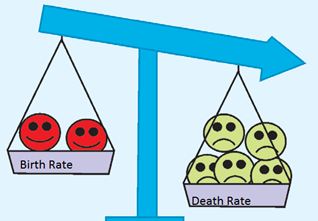Human Resources - Worksheets
CBSE Worksheet 01
Ch-18 Human Resources
Ch-18 Human Resources
- If the birth rate is high and the death rate is low in a country then the population pyramid will
- Narrow at the base
- Not narrow at the base
- Not narrow rapidly towards the top
- Narrow rapidly towards the top
- Human resources differ from one another in respect of
- educational level
- All of these
- age
- sex
- What does the following image infer?

- All of the above
- Decrease in population
- Increase in population
- Balanced population
- Most of the people usually prefer to live in this region:
- Equatorial forest area
- High altitude areas
- High mountains
- Plains
- In India, in how many years once is Census is taken?
- 25
- 15
- 10
- 20
- Match the following:
Column A Column B (i) Migration (a) Movement of people to other countries (ii) Emigration (b) Geographical factor (iii) Life expectancy (c) The movement of people in and out of an area (iv) Climate (d) The number of years for which an average man expects to live. - Fill in the blanks:
- ________is the ultimate resource.
- ________in Japan and________in India are two densely populated areas.
- Varanasi, Jerusalem and Vatican city are some examples of ________factors.
- In 1999, less than 30 years later, the population doubled to________billion.
- State True or False:
- The most dynamic aspect of the geographic study of population is migration.
- Sex ratio is the number of females per 1000 males in the total population.
- The age group of 0-14 years considered as an unproductive group.
- Literacy means the ability to read, write and understand.
- What is human resource?
- The world population has grown very rapidly. Why?
- What does immigration refer to?
- Why are people considered a resource?
- Briefly describe the factors affecting distribution of population.
CBSE Worksheet 01
Ch-18 Human Resources
Ch-18 Human Resources
Answer
- Not narrow rapidly towards the top, Explanation: In the population pyramid of a country, in which birth rate is high has a broader base and if the ceath rate is low it will not be rapidly narrows towards the top but will be little broader.
- All of these, Explanation: All of these. Human resources differ from one another in respect of:
- age.
- educational level.
- sex.
- All of these, Explanation: All of these. Human resources differ from one another in respect of:
- Decrease in population, Explanation: From the image, we infer that : Death rate is more than birth rate which inturn decreases the population.
- Plains, Explanation: Most people usually prefer to live in plains region.
- 10, Explanation: Census is the process of taking count of total population of the country. In India, it is held for every ten years.
- Migration - (c) The movement of people in and out of an area
- Emigration - (a) Movement of people to other countries
- Life expectancy - (d) The number of years for which an average man expects to live.
- Climate - (b) Geographical factor
- Human resource
- Osaka, Mumbai
- religious or cultural
- 6
- False
- True
- True
- True
- Human resource is the ultimate resource. Healthy, educated and motivated people develop resources as per their requirements.
- Development in medical science has caused a decrease in death rate so the world population has grown very rapidly.
- The process of entering a new country to settle permanently is called immigration.
- People are a nation's greatest resources. Human beings use resources with their intelligence and skills and turn all-natural resources into useful products. Health, education, motivation and skills turn the people into human resources.
- The main factors which affect the distribution of population are geographical, social, cultural and economic factors.
Geographical Factors: Topography, climate, soil, water, minerals are the geographical factors. People prefer to live on plains rather than mountains and plateaus. People like to live in moderate climates than extremely hot or extremely cold climates. People prefer fertile soil areas for agriculture. Areas with the availability of fresh-water and mineral deposits are densely populated.
Social, Cultural and Economic Factors: Areas of better housing, education, health facilities are more densely populated. Places with religious or cultural significance attract people. Industrial areas provide employment opportunities. A large number of people are attracted to these areas.
